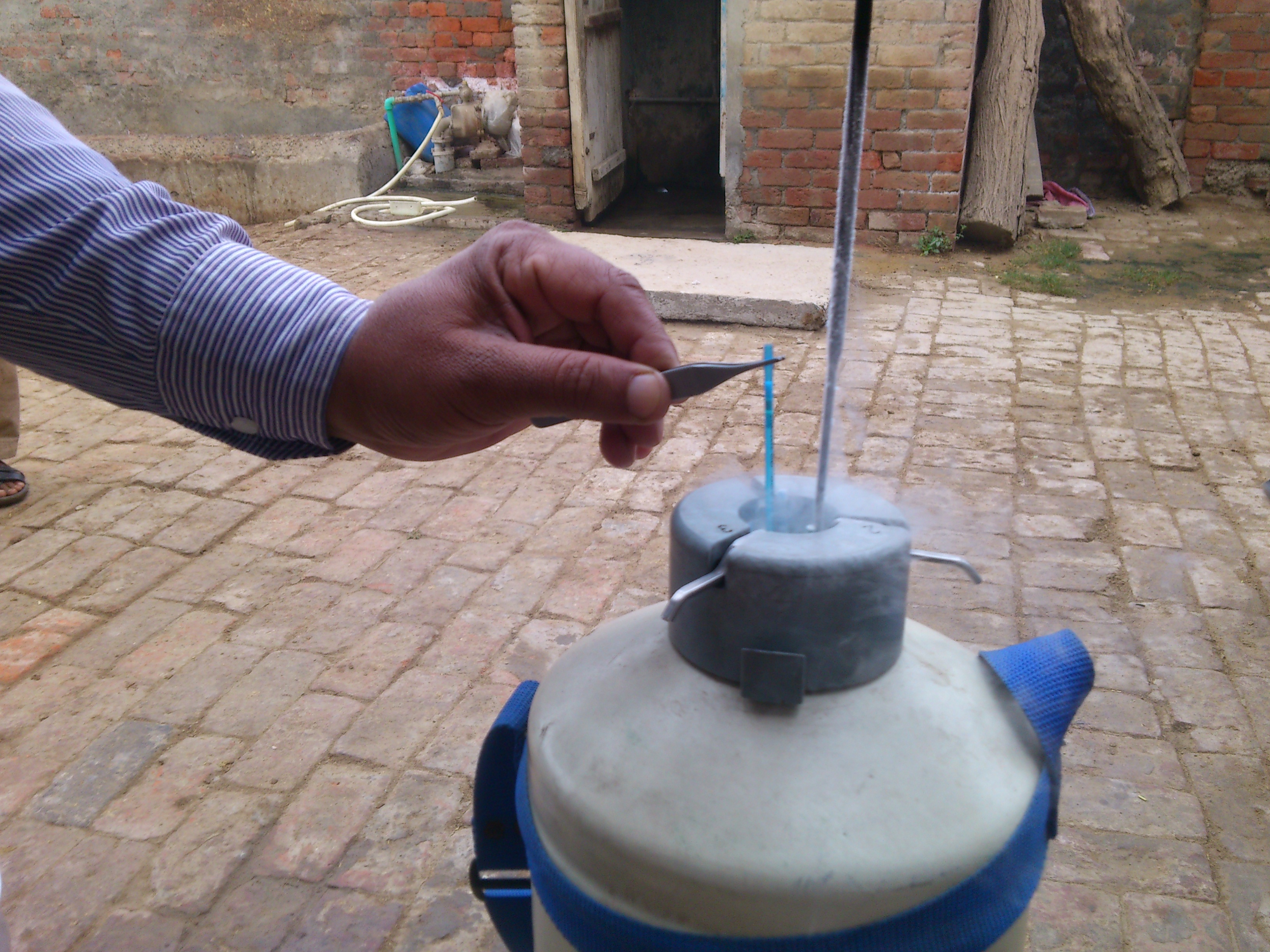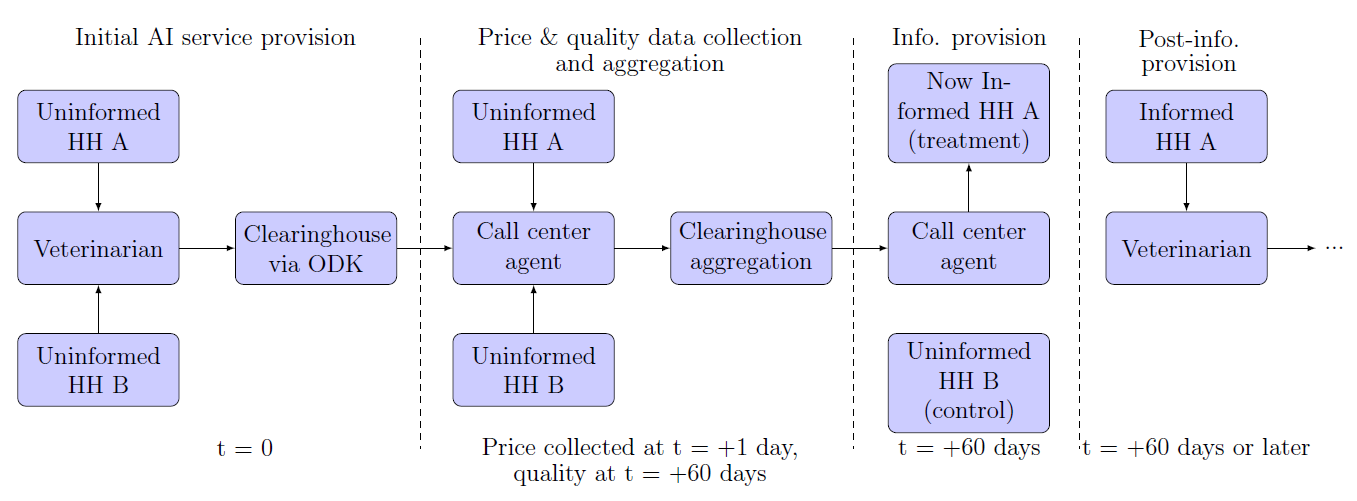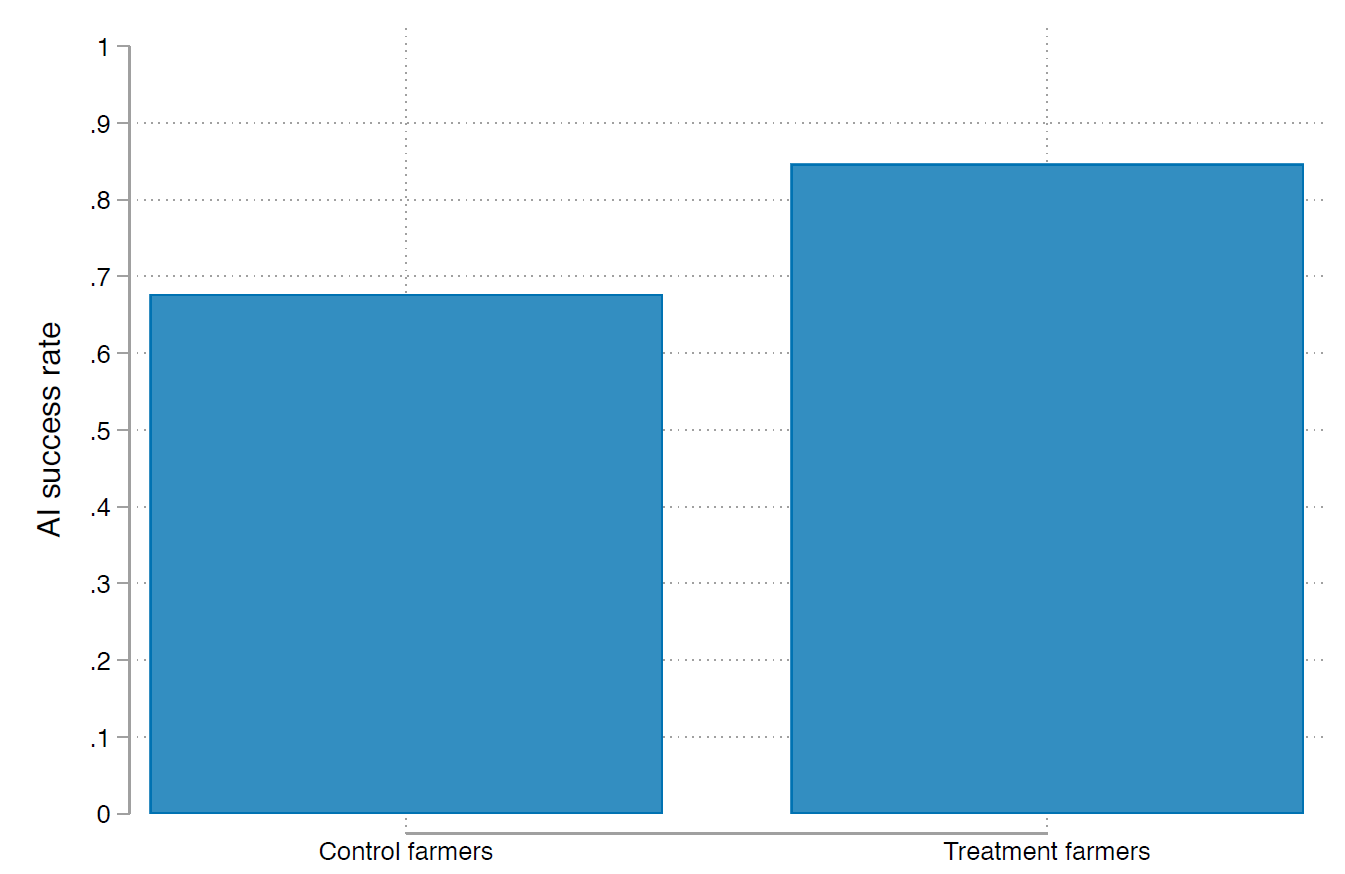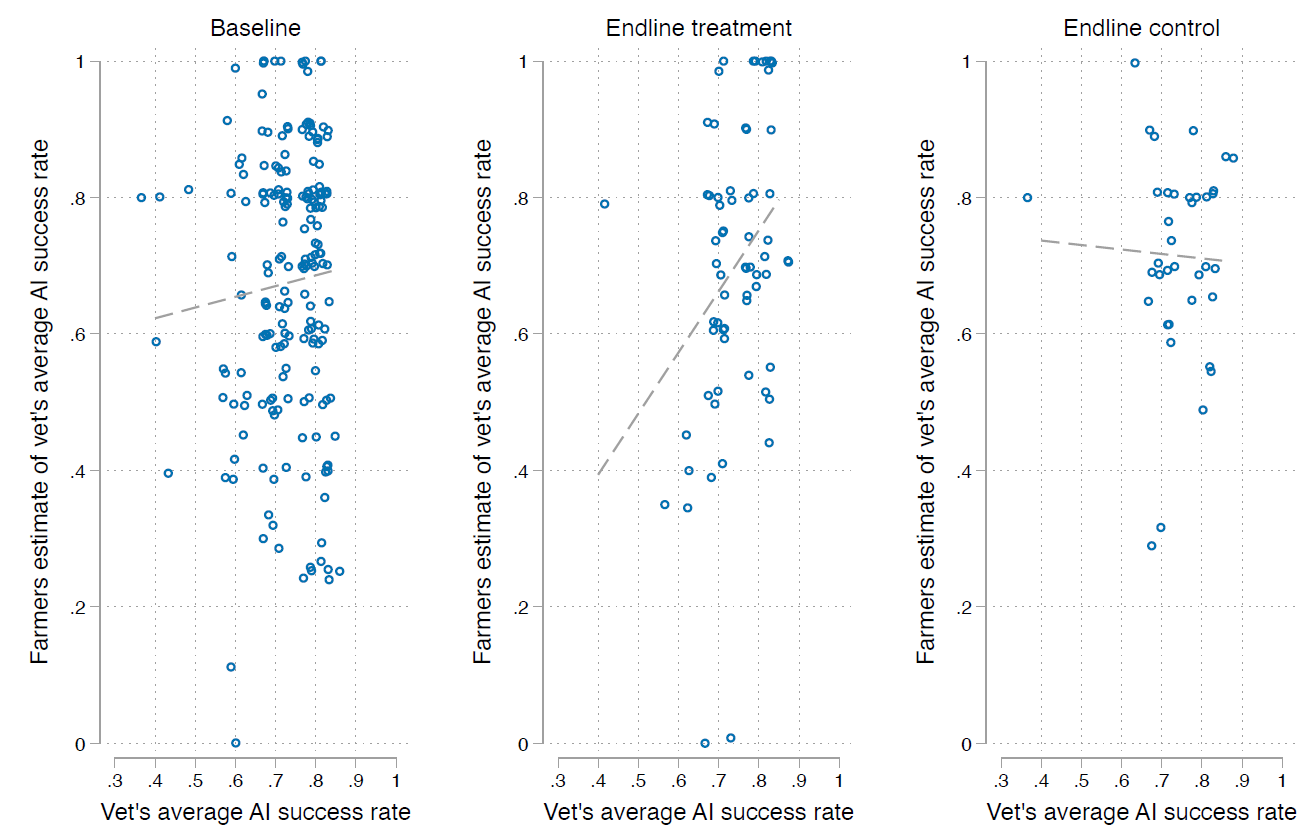
An information clearinghouse provided accurate information to rural farmers in Pakistan, reducing information asymmetries and increasing veterinarian effort
Information asymmetry, i.e. when there is an imbalance in the knowledge of different parties during an interaction, is a feature of life across the world and often leads to sub-optimal outcomes for the rural poor in developing countries (World Bank 2004, Wild et al. 2012). This asymmetry can be leveraged by rent-seeking government personnel (Muralidharan et al. 2021, Ferraz and Finan 2011, Bandiera et al. 2009, Chaudhury et al. 2006, Reinikka and Svensson 2004) and private actors alike (Kelley et al. 2021, Aker 2010, Svensson and Yanagizawa 2009, Jensen 2007). It can also mean that potential gains from trade go unharnessed, to the detriment of both consumers and suppliers of goods and services. While contextual details and strategic options of individuals in different circumstance vary wildly, traditional theories of moral hazard and/or adverse selection often describe the outcomes of asymmetric information well (following Hölmstrom 1979, Akerlof 1970).
The context: Livestock insemination in rural Punjab
We study asymmetric information in an important developing-country context: the market for artificial insemination of livestock in rural Punjab, Pakistan. Artificial insemination is crucial to renewing livestock. Most households in our context prefer to keep female cows only, because these provide additional revenue streams by producing milk and calves, both of which require cows to undergo pregnancy. Livestock accounts for nearly two-thirds of Pakistan’s agricultural output and 12% of the country’s GDP. This makes it the second largest sector in the economy - bigger than all manufacturing put together - and a key growth sector for the rural poor (Pakistan Economic Survey 2021-22).
The challenge: Evaluating veterinary services
Farmers face challenges in evaluating the quality of the work done by veterinarians providing artificial insemination services: they can neither directly check the quality of the insemination straws used, nor assess the technique and care taken in application. Both variables impact the likelihood of pregnancy. Further uncertainty arises because if the animal fails to get pregnant, this could have been caused by poor artificial insemination service, but also due to other factors, including the animal’s health, nutrition and climatic factors. The farmer thus has a noisy signal of veterinarian quality, which means that the market for artificial insemination is one in which asymmetric information plays a significant role. This results in artificial insemination success rates that are lower than technologically possible, costing farmers potential income in the form of calves that are never born and milk that is never lactated. If artificial insemination is less financially attractive to farmers, demand for veterinarians may be impacted too.
Figure 1: A veterinarian removing a semen straw from a liquid nitrogen container prior to performing artificial insemination

A potential solution? Piloting an information clearinghouse
To tackle this, we piloted an information clearinghouse (similar to a yelp.com or an angieslist.com) to measure and reveal information about artificial insemination service provision to rural households in one district of Pakistan’s Punjab province. Specifically, the system provided households information about local public-sector veterinarians’ average success rates at artificially inseminating livestock, an objective measure of veterinarian effort, the average artificial insemination service price charged by each local veterinarian, and the number of observations used to estimate these averages.
The clearinghouse gathered and disseminated this information from a large base of farmers, in real time, using a call centre. This clearinghouse was novel not only in that it leveraged the cost-effective, self-sustaining nature of crowdsourcing to help the poorest, but also in that it did so in a particularly tough setting. In our study district of Sahiwal, only about half of the population was literate at the time of our study, and cellular networks were limited and expensive relative to most farmers’ income levels. Our system did not require that farmers have smartphones.
Figure 2: Clearinghouse flowchart; arrows indicate the flow of information

Results from this intervention
We measure the impact of decreased asymmetric information via this clearinghouse using a randomised controlled trial, finding that farmers treated with information on local government veterinarians’ artificial insemination success rates and prices have a 25% higher artificial insemination success rate than controls, without paying higher prices. In addition, treatment farmers who return to a government veterinarian for artificial insemination rather than seeking a private provider after treatment selection see 61% higher artificial insemination success rates.
Figure 3: Treatment effect of receiving veterinarian ratings on farmer artificial insemination success rates

What explains this success?
Interestingly, farmers provided clearinghouse information enjoy improved artificial insemination success rates, without paying higher prices, despite not switching government veterinarians. Thus the results we observe cannot be driven by farmers simply switching to the ‘best vet’ in terms of artificial insemination success and/or price. We also find that the effect cannot be driven purely by changes in livestock care, as treatment farmers who subsequently switch to private providers do not have increased artificial insemination success rates.
To help understand the possible channel(s) for these effects, we develop a simple stylised model based on Klein et al. (2016). While this model and our data allow us to rule out some channels (e.g. decreased adverse selection through the exit of low quality veterinarians from the market does not seem to drive our results), in fact our results are consistent with some combination of (i) fewer low quality veterinarians masquerading as high, (ii) fewer veterinarians putting in low effort when farmers pay a premium expecting high effort, and (iii) farmers’ improved bargaining power as a result of learning how their current veterinarian compares to other, high quality, veterinarians nearby.
Public sector veterinarians providing artificial insemination services in Punjab collect a regular salary and are protected from punishment for poor performance, but are also legally allowed to charge farmers a private fee on top of the government-mandated fee. As a result, when their low unobserved effort is revealed to farmers, these veterinarians may prefer to exert more effort to continue collecting the extra fee they can pocket as opposed to losing a customer. In other words, they may internalise the benefits of their marginal effort, a characteristic more common to private than public markets. This ensures they respond when the market becomes more contested.
We find that additional results are consistent with our stylised model. First, farmers’ initial beliefs about the average artificial insemination success rate of their own government veterinarians are completely inaccurate when compared to true artificial insemination success rates measured by the clearinghouse. Second, treatment causes farmers’ beliefs to become much more accurate. Third, the amount of information farmers receive determines their benefit vis-a-vis the channels mentioned above (farmers who received more negative – and thus valuable – information relative to their expectations saw larger treatment effects).
Figure 4: Treatment effect on farmer beliefs

Implications and conclusions
More generally, the market for artificial insemination in rural Punjab is one in which informationally disadvantaged consumers pay more than the marginal cost of artificial insemination provision through higher-than-necessary prices and lower-than-warranted veterinarian effort. In this market, treatment-induced veterinarian effort implies consumer welfare gains provided there are no compensating price increases or negative spillovers onto control farmers, of which we find no evidence. This implies overall social welfare gains so long as the cost to veterinarians’ increased effort is not too great. Conservative estimates suggest a 275% return on the cost of the intervention. Overall, our study highlights the positive impact that Information & Communications Technology (ICT) interventions to tackle market failure can have, even in technologically-poor, low-capacity settings.
References
Aker, J C (2010), “Information from markets near and far: Mobile phones and agricultural markets in Niger,” American Economic Journal: Applied Economics, 2(3): 46–59.
Akerlof, G A (1970), “The market for 'lemons': Quality uncertainty and the market mechanism,” The Quarterly Journal of Economics: 488–500.
Bandiera, O, A Prat, and T Valletti (2009), “Active and passive waste in government spending: Evidence from a policy experiment,” American Economic Review, 99(4): 1278–1308.
Chaudhury, N, J Hammer, M Kremer, K Muralidharan, and F H Rogers (2006), “Missing in action: teacher and health worker absence in developing countries,” The Journal of Economic Perspectives, 20(1): 91–116.
Ferraz, C and F Finan (2011), “Electoral accountability and corruption: Evidence from the audits of local governments,” American Economic Review, 101(4): 1274–1311.
Hölmstrom, B (1979), “Moral hazard and observability,” The Bell Journal of Economics: 74–91.
Jensen, R (2007), “The digital provide: Information (technology), market performance, and welfare in the South Indian fisheries sector,” The Quarterly Journal of Economics: 879–924.
Kelley, E M, G Lane, and D Schönholzer (2021), “Monitoring in small firms: Experimental evidence from Kenyan public transit,” Working paper.
Klein, T J, C Lambertz, and K O Stahl (2016), “Market transparency, adverse selection, and moral hazard,” Journal of Political Economy, 124(6): 1677–1713.
Muralidharan, K, P Niehaus, S Sukhtankar, and J Weaver (2021), “Improving last-mile service delivery using phone-based monitoring,” American Economic Journal: Applied Economics, 13(2): 52–82.
Reinikka, R and J Svensson (2004), “Local capture: Evidence from a central government transfer programme in Uganda,” The Quarterly Journal of Economics, 119(2): 679–705.
Svensson, J and D Yanagizawa (2009), “Getting prices right: The impact of the market information service in Uganda,” Journal of the European Economic Association, 7(2-3): 435–445.
Wild, L, V Chambers, M King, and D Harris (2012), “Common constraints and incentive problems in service delivery,” Tech. rep., Overseas Development Institute.
World Bank (2004), World Development Report 2004: Making Services Work for the Poor, World Bank.



